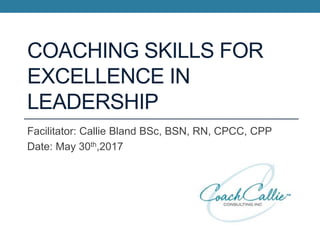Coaching Skills for Excellence in Leadership
- 1. COACHING SKILLS FOR EXCELLENCE IN LEADERSHIP Facilitator: Callie Bland BSc, BSN, RN, CPCC, CPP Date: May 30th,2017
- 2. Learning Objectives 1. Understand the principles of a coach conversation 2. Apply the qualities of experiential listening and the art of curious questions 3. Learn how to structure a coaching conversation 4. Discover how to tell/and give advice using a coach approach. 5. Identify opportunities to implement a coach approach to help navigate people through change
- 3. What is Coaching “The ICF defines coaching as partnering with another person in a thought-provoking and creative process that inspires them to maximize their personal and professional potential.” Transformation International Coach Federation, 2015
- 4. Coaching Principles 1. Trusting partnership. 2. People are not broken and don’t need fixing. 3. People are creative and resourceful to discover their own solution/strategies. 4. Coaching is action oriented. 5. The other “person” takes ownership/responsibility. 6. Curious/non-judgmental.
- 5. Benefits of Coach Approach • Develop critical thinking and decision making skills of staff • Increase staff self awareness of strengths and opportunities to improve • Increases sense of responsibility and accountability • Enhances creativity, resourcefulness and resilience • Increases collaborative approach to overcome challenges and achieve results • Focus on solutions rather than problems • Engages staff • Transformational
- 6. Foundational Coaching Skills 1. Listening 2. Powerful Questions
- 7. Levels of Listening Level 1 • Tracking words while engaged in another task or thought simultaneously. • Emerges when internally or externally multitasking. Level 2 • Attention is on the words. • The question running through your mind is “what does this mean to me?” Level 3 or Experiential • Listening to the other’s experience. • The question running through your mind is “what does this mean to him/her?”
- 8. What are you listening for? 3 components in an experience Feelings Thoughts/assumptions Values/Wants/Needs
- 9. Level 3 Listening Reflect back on a conversation you had with a direct report or colleague it didn’t go well. 1. What was the other person thinking? 2. How might he/she have been feeling? 3. What did the he/she want or need?
- 10. Listening • Listening is a skill which needs to be practiced. • Evidence of effective listening is that people feel seen, heard, and valued. • Involves seeking to understand before being understood. • Cultivates presence and connection. • Builds trust.
- 11. Curious Questions Questions that engage people by stimulating introspection, insight, creativity and responsibility. Qualities: • Don’t already have the “right” answer already made up in your mind • Open and expansive • Typically use who, what, where and how • Doesn’t lead to a YES/NO answer
- 12. Open Questions Examples 1. What do you want? 2. What does your best performance look like? 3. What resources are available to you? 4. How much time do you need to implement change? 5. What are the possible solutions to help you move forward?
- 13. Structure of a Coaching Conversation 1. Set up the conversation 2. Explore/brainstorm 3. Create action plan 4. Assess confidence 5. Design Accountability
- 14. Set up a Coaching Conversation Identify Topic Clarify Agenda Assess Current State Clarify Time Align Expectati ons
- 15. Set up a Coaching Conversation 1. What is the topic for the conversation? 2. What do you want to achieve as a result of our conversation? 3. How much time do we want to devote to this conversation or topic? 4. Where are you now? 5. I think we can achieve _____ in the context of this conversation, how does that work for you?
- 17. Create Action Plan Action planning involves specifying what, when, where and how to enact a goal-directed behavior. 1. What do you want to do as a result of our conversation? 2. What will you commit to and when will you do it?
- 18. Assess Confidence Rate confidence On a scale of 0-10 how confident are you about taking the actions you committed to? If people rate 7 or below get curious about what would help them raise their confidence level to take action.
- 19. Design Accountability 1. What type of accountability would you like around this? 2. How would you like to be held accountable? 3. What do you need in terms of accountability?
- 20. Positive Visuals • More likely to engage and be sustainably motivated to pursue a positive visual than a negative visual. • State what you want, not what you don’t want.
- 21. Telling/Giving Advice Telling and giving advice is an essential component of being a leader. 1. Check in to see what the person already knows 2. Share your intention 3. Ask permission
- 22. • The righting reflect is the natural desire to correct someone. • People have a tendency to resist persuasion, especially when ambivalent and correcting the person can increase resistance to change. • Recognize that the person’s may argue and your role is to guide them through their ambivalence and understand their motivations for change. Miller, W. R., Rollnick, S. (2002). Motivational Interviewing: Preparing People for Change. 2nd Edition. New York: Guilford Pres Righting Reflex
- 23. Opportunities to implement What scenarios/conversations are a good fit for a coach approach in your organization?
- 24. Confidence ✓Know your strengths and lead with them. ✓Set a SMART goal to improve/implement a coaching approach. ✓Take risks, get out of your comfort zone.
- 25. Complete
